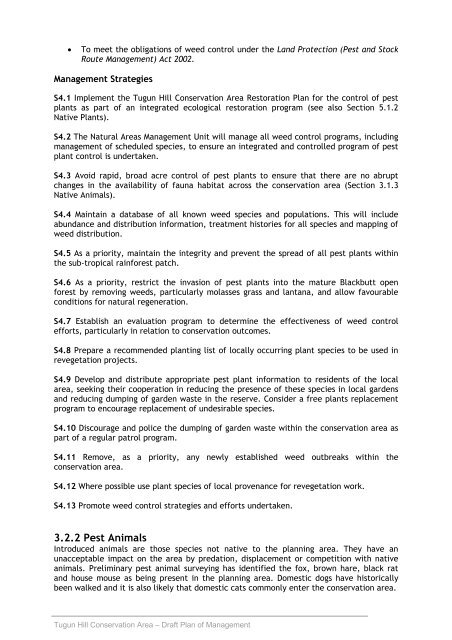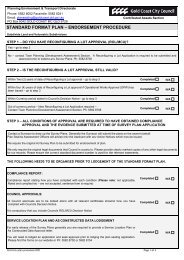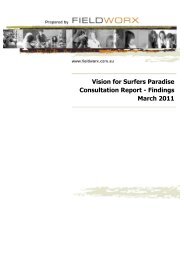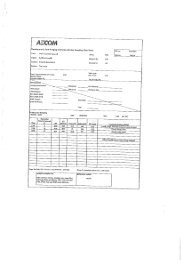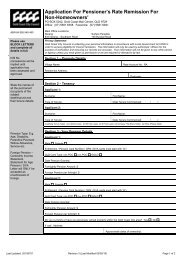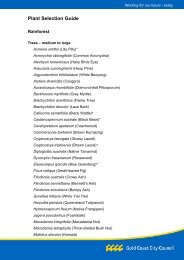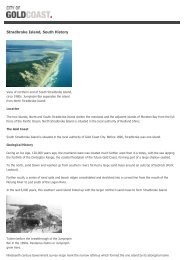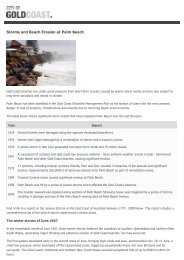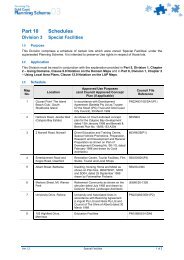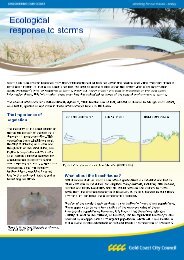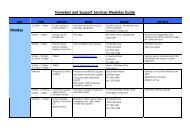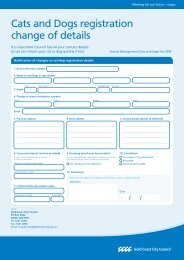Draft Tugun Hill Conservation Area Plan of Management
Draft Tugun Hill Conservation Area Plan of Management
Draft Tugun Hill Conservation Area Plan of Management
Create successful ePaper yourself
Turn your PDF publications into a flip-book with our unique Google optimized e-Paper software.
• To meet the obligations <strong>of</strong> weed control under the Land Protection (Pest and Stock<br />
Route <strong>Management</strong>) Act 2002.<br />
<strong>Management</strong> Strategies<br />
S4.1 Implement the <strong>Tugun</strong> <strong>Hill</strong> <strong>Conservation</strong> <strong>Area</strong> Restoration <strong>Plan</strong> for the control <strong>of</strong> pest<br />
plants as part <strong>of</strong> an integrated ecological restoration program (see also Section 5.1.2<br />
Native <strong>Plan</strong>ts).<br />
S4.2 The Natural <strong>Area</strong>s <strong>Management</strong> Unit will manage all weed control programs, including<br />
management <strong>of</strong> scheduled species, to ensure an integrated and controlled program <strong>of</strong> pest<br />
plant control is undertaken.<br />
S4.3 Avoid rapid, broad acre control <strong>of</strong> pest plants to ensure that there are no abrupt<br />
changes in the availability <strong>of</strong> fauna habitat across the conservation area (Section 3.1.3<br />
Native Animals).<br />
S4.4 Maintain a database <strong>of</strong> all known weed species and populations. This will include<br />
abundance and distribution information, treatment histories for all species and mapping <strong>of</strong><br />
weed distribution.<br />
S4.5 As a priority, maintain the integrity and prevent the spread <strong>of</strong> all pest plants within<br />
the sub-tropical rainforest patch.<br />
S4.6 As a priority, restrict the invasion <strong>of</strong> pest plants into the mature Blackbutt open<br />
forest by removing weeds, particularly molasses grass and lantana, and allow favourable<br />
conditions for natural regeneration.<br />
S4.7 Establish an evaluation program to determine the effectiveness <strong>of</strong> weed control<br />
efforts, particularly in relation to conservation outcomes.<br />
S4.8 Prepare a recommended planting list <strong>of</strong> locally occurring plant species to be used in<br />
revegetation projects.<br />
S4.9 Develop and distribute appropriate pest plant information to residents <strong>of</strong> the local<br />
area, seeking their cooperation in reducing the presence <strong>of</strong> these species in local gardens<br />
and reducing dumping <strong>of</strong> garden waste in the reserve. Consider a free plants replacement<br />
program to encourage replacement <strong>of</strong> undesirable species.<br />
S4.10 Discourage and police the dumping <strong>of</strong> garden waste within the conservation area as<br />
part <strong>of</strong> a regular patrol program.<br />
S4.11 Remove, as a priority, any newly established weed outbreaks within the<br />
conservation area.<br />
S4.12 Where possible use plant species <strong>of</strong> local provenance for revegetation work.<br />
S4.13 Promote weed control strategies and efforts undertaken.<br />
3.2.2 Pest Animals<br />
Introduced animals are those species not native to the planning area. They have an<br />
unacceptable impact on the area by predation, displacement or competition with native<br />
animals. Preliminary pest animal surveying has identified the fox, brown hare, black rat<br />
and house mouse as being present in the planning area. Domestic dogs have historically<br />
been walked and it is also likely that domestic cats commonly enter the conservation area.<br />
<strong>Tugun</strong> <strong>Hill</strong> <strong>Conservation</strong> <strong>Area</strong> – <strong>Draft</strong> <strong>Plan</strong> <strong>of</strong> <strong>Management</strong>


